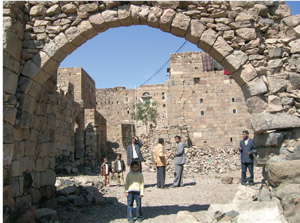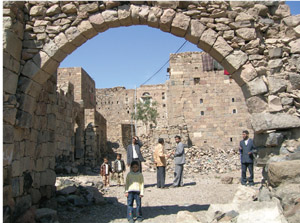
Ghaiman: Where reality blends with myth [Archives:2006/1009/Last Page]
December 21 2006
 |
According to one local, Ghaiman was Yemen's capital during the pre-Islamic era, particularly under King Asa'ad Al-Kamil.
Located just 20 km. from Sana'a, very few people know its history. Ghaiman is a fort with a large number of historical features, cisterns, paved roads and sturdy walls; however, most of these monuments are now ruins.
Ghaiman was the name of what is now Nuqum Mountain in eastern Sana'a, as well as the name of a famous fortified fort and archeological area southeast of Sana'a. Administratively, Ghaiman is part of Bani Behlol district and tribally, it belongs to Khawlan Al-Tiyal. Sanhan district recently annexed Bani Behlol.
Located atop a small hill, Ghaiman is bordered by Al-Hagarah village and Qarowan Mountain in the north, Jaoub and Skhaleet villages to the south, Wadi Jubaib and Al-Ligum to the east and Raymat Humaid to the west. Important valleys in Ghaiman include Nais, Al-Mahjar and Al-Ghail.
Ghaiman is not as it used to be, as numerous houses have sprung up in the wadis beneath the fort and very few people still inhabit the fort.
Three famous old mosques were built within the fort throughout different periods of the Islamic era. Built in a magnificent manner, they are full of Islamic inscriptions and contain deep cisterns.
Some mosques contain old tombs of pious and religious figures that were raided in search of gold; however, such searches yielded nothing because most of the tombs were from the Islamic period, whereas gold was from the pre-Islamic era.
In the past, Ghaiman was the area's most fortified fort with a wall surrounding its entirety. Entry was via two doors, Bab Al-Balad to the east and Bab Al-Qudmah to the west. These doors still exist, whereas the fort's surrounding walls and other monuments since have disappeared.
Ghaiman's most important historical and archeological features include King Asa'ad's palace, Asa'ad's Cistern and a long underground tunnel linking the fort to Al-Kalb (dog) Well in the wadi below. Used during war or siege, the tunnel enabled inhabitants to descend to the wadi for water without being seen by the enemy.
However, only remnants of these monuments remain, like King Asa'ad's Palace, a one-story structure built of long white marble-like stones locally known as al-balaq, together with black stones forming the foundation's bottom two rows.
Despite the fact that very few paved roads now exist within the fort, most of its roads were paved with white stones. The cistern currently contains no water and the tunnel was blocked from the fort side, thus it was impossible to enter it.
Most inscribed stones, such as a temple-shaped stone and another known as Asa'ad's Foot, were taken from their original locations and placed elsewhere both within and outside the fort.
The area including and surrounding Ghaiman supposedly contains large quantities of buried gold. In searching for it, locals dug at various sites in the fort, but very few found any – some found gold while others didn't. All such previous attempts were individual, as the government in Ghaiman has undertaken no systematic digs like at other archeological sites across Yemen.
——
[archive-e:1009-v:14-y:2006-d:2006-12-21-p:lastpage]


